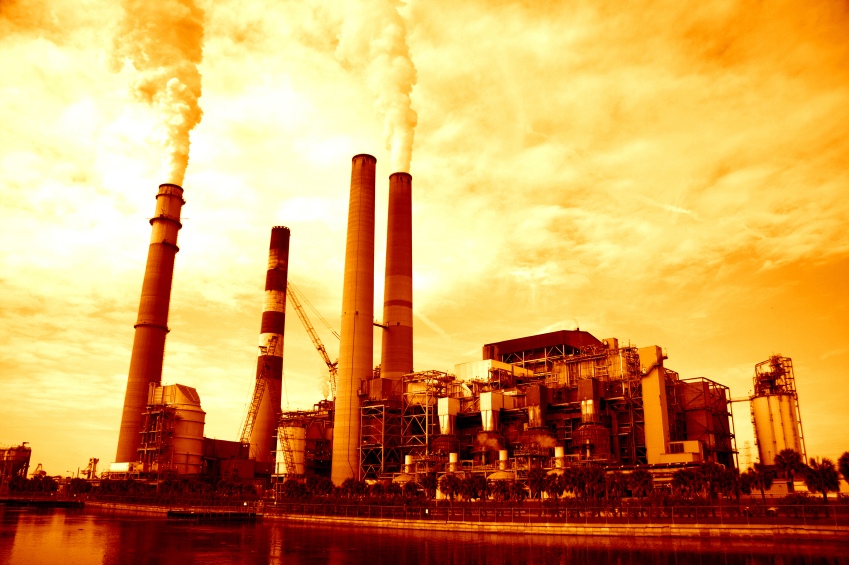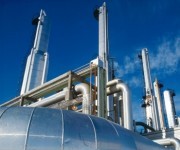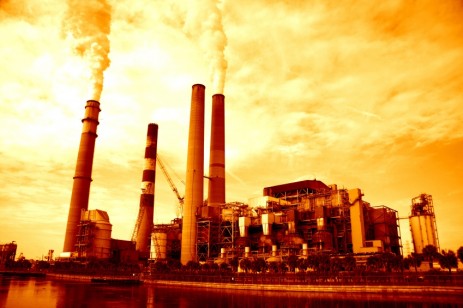 Watch your back, coal plant.
Watch your back, coal plant.
The EPA effectively went into deep freeze under George W. Bush, so there’s a lot of catching up to do to keep the Clean Air Act and other environmental laws in line with the best science. Lisa Jackson’s EPA is working furiously on just that. They’ve got several irons in the fire right now. Coal-dominated utilities are terrified.
Here are the two most significant (non-CO2) regulations on the EPA’s plate right now.
1. National Emission Standard for Hazardous Air Pollutants (NESHAPs)
By March of next year, EPA will release (court-mandated) new standards governing hazardous pollutants like mercury and acid gases under Section 112 of the Clean Air Act. These standards have been a looong time coming. (Frank O’Donnell tells the tale; see also “The Hidden Human and Environmental Costs of Regulatory Delay” from the Center for Progressive Reform.) Two significant things about them:
- The standards apply to all coal-fired power plants, old as well as new.
- These are MACT — maximum achievable control technology — standards, which means all plants will have to match the performance of the top-performing 12 percent. There are some options with mercury, but with acid gases that basically means installing wet scrubbers, which are extremely expensive. All power plants must be in compliance by 2015, which is a fairly short window.
Note: Natural-gas power plants emit no HAPs — no mercury, no acid gases. Obviously regulations on HAPs will differentially advantage gas.
2. The Clean Air Transport Rule (CATR)
The recently released CATR regulates sulfur dioxide (SO2) and nitrogen oxides (NOx). It’s designed to protect states (mostly Eastern states) from pollution that blows across state lines. EPA says the rule will reduce power plant SO2 emissions 71 percent over 2005 levels by 2014, and NOx emissions 52 percent. CATR is a revision of the Bush administration’s Clean Air Interstate Rule (CAIR), key parts of which were invalidated in court.
Note: Natural-gas power plants emit no SO2 and much less NOx than coal plants. Again, these regulations will advantage gas.
——
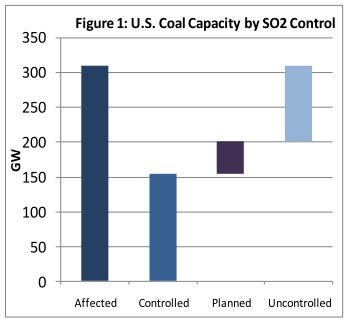 ICF International: “Coal-Fired Electric Generation Unit Retirement Analysis“
ICF International: “Coal-Fired Electric Generation Unit Retirement Analysis“
Both NESHAPs and CATR serve to force uncontrolled plants to install SO2 scrubbers. Some will find it cheaper to shut down than to make the considerable investment. Exactly how many? That depends on some educated guesses about how old is too old, or how inefficient is too inefficient, for an upgrade to be worth the expense. It also depends importantly on the ongoing price of natural gas, coal’s primary near-term competitor.
According to a report by consultancy ICF International [PDF] …
… approximately 50 percent of the unscrubbed plants or roughly 50 GW of coal fueled generating capacity is “at risk” for retirement across the U.S. in the near- mid-term.
Here’s the projected effect of the regulations according to a similar report from Bernstein Research [PDF]:
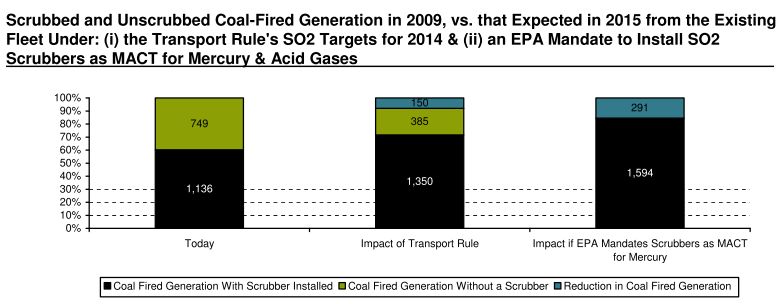 Bernstein Research: “Black Days Ahead for Coal: Implications of EPA Air Emissions Regulations for the Energy & Power Markets”
Bernstein Research: “Black Days Ahead for Coal: Implications of EPA Air Emissions Regulations for the Energy & Power Markets”
There will still be plenty of coal operating, but the oldest, dirtiest, least efficient stuff will finally be excised and what remains will be substantially cleaner. The coal fight will go on, but finally having pollution scrubbers on every operating American coal plant will be a Big F’ing Deal, especially for the often low-income and marginal urban communities who suffer the worst effects of air pollution. This is from a new report by M.J. Bradley & Associates [PDF]:
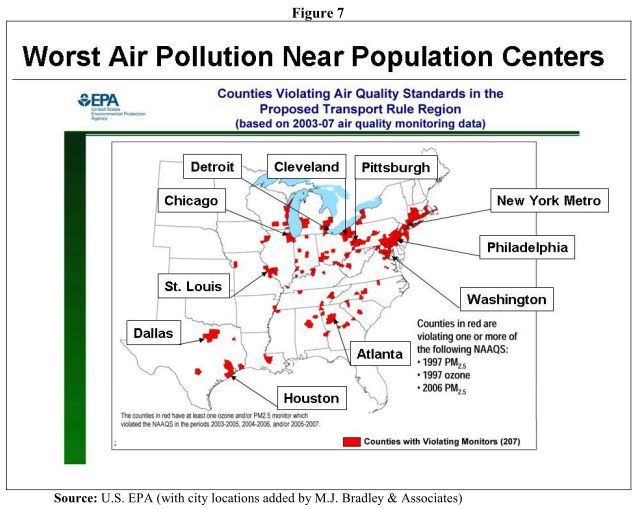 M.J. Bradley & Associates: “Ensuring a Clean, Modern Electric Generating Fleet while Maintaining Electric System Reliability“
M.J. Bradley & Associates: “Ensuring a Clean, Modern Electric Generating Fleet while Maintaining Electric System Reliability“
In terms of politics, obviously it matters where the effects of the regulations will be concentrated. Here’s where the at-risk plants are, from ICF:
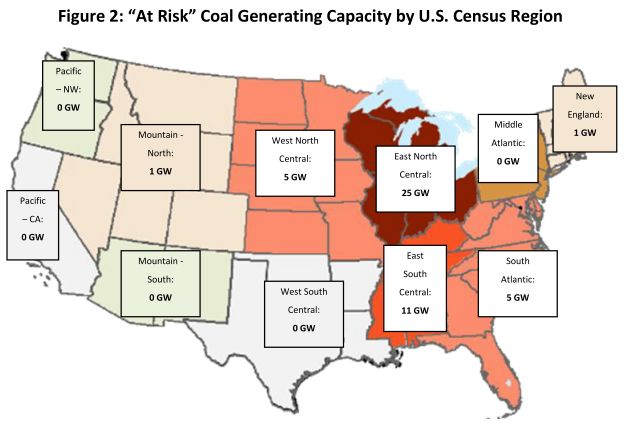 ICF International: “Coal-Fired Electric Generation Unit Retirement Analysis“
ICF International: “Coal-Fired Electric Generation Unit Retirement Analysis“
As you can see, the vast bulk of the at-risk plants are in the Central and Southeast areas. Once again: climate politics in a nutshell.
Another way to look at the effects of the regulations is in terms of energy generation. This is from ICF:
In order to meet electric demand, the system would need to replace the roughly 250,000 GWh per year of this retired capacity from the “at risk” coal power plants.
And from Bernstein:
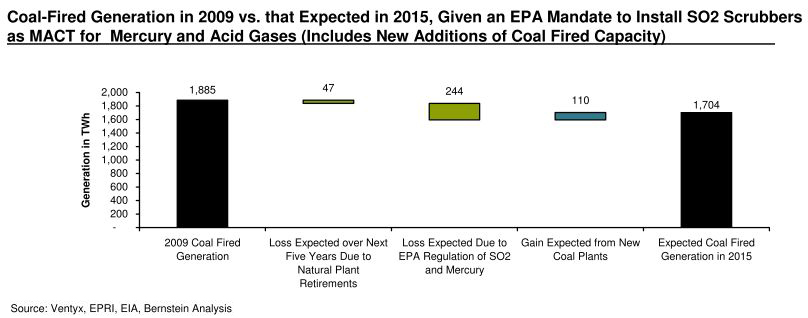 Bernstein Research: “Black Days Ahead for Coal: Implications of EPA Air Emissions Regulations for the Energy & Power Markets”
Bernstein Research: “Black Days Ahead for Coal: Implications of EPA Air Emissions Regulations for the Energy & Power Markets”
Can the regions affected by the new EPA regulations replace the coal energy they’re going to lose with something else in time to keep all the lights on? What can or will displace coal? Before we look at those questions, let’s take a quick look at a few other regs that will hasten the demise of dirty coal.

